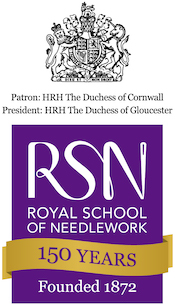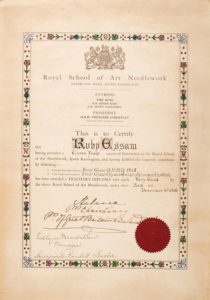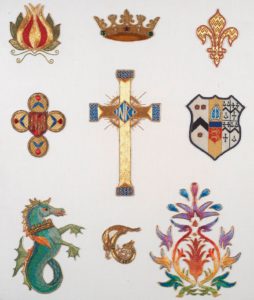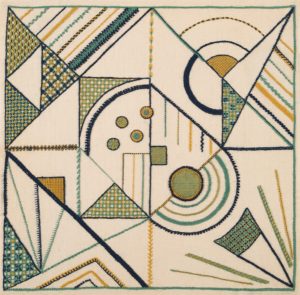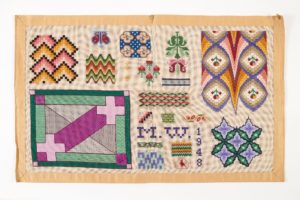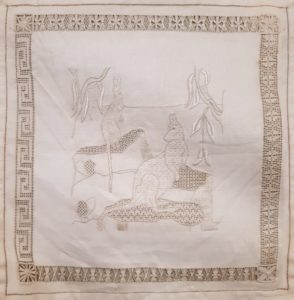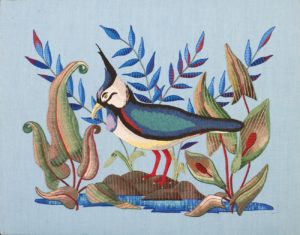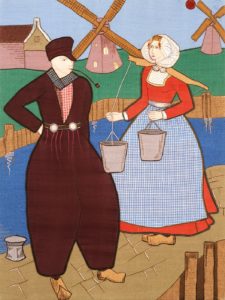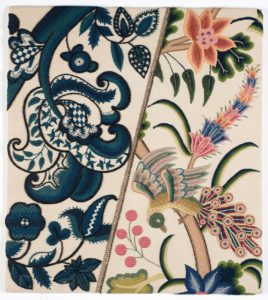Training School Diploma
I50 Years of the RSN: Virtual Exhibition
In the 1890s there was a push by the government to promote technical education and Princess Helena wanted to be seen at the forefront of this movement. In 1895 the RSN’s governing body agreed to launch a new training programme, a two-year Certificate or a three-year Diploma, holders of which would be able to teach in schools or in the new technical colleges. Graduates went on to teach not just in the UK, but all over the world, the most famous of whom was probably Erica Wilson.
A short while later, the RSN’s governing Council became aware that many of those teaching embroidery in the technical colleges were self-taught and so they proposed offering evening classes. These would run five nights a week: two on embroidery, two on design and one night for what the RSN calls ‘Work on Own’, when there would not be any teaching but the classroom would be open for students to do their own work. This was an important provision as many students did not have space at home to set up frames. The evening school classes were launched with a lecture by Walter Crane.
The Training School Diploma ran until 1961 when it was stopped abruptly after the Ministry of Education wanted significant changes and the RSN did not have the funds to put these in place.
Evening school classes continued, except during the Second World War, until the end of the 1980s when, with the move to Hampton Court Palace, there was no longer a suitable, accessible building for such classes.
Miss Ruby Essam’s Certificate
1916
Paper, framed
Miss Ruby Essam joined the RSN in 1913, completing the three-year Diploma in 1916. This is her certificate signed by Princess Helena as President, Miss Evelyn Bradshaw, Principal and Miss Marguerite Randell Head of the Training School. Miss Essam went straight into the RSN workroom where she stayed until she retired in 1976 – making her the longest serving RSN person with 63 years. During that time she worked on two coronations, the Overlord Embroidery and even a piece for an American Ambassador. The certificate was returned to the RSN in 2011 by Miss Essam’s great-nephew.
Diploma Crewelwork
1900-early 1950s
Linen twill with crewel wool embroidery
This four-part design was used until the last few years of the Training School Diploma. It taught students the wide range of surface stitches that are part of crewel work including shading and it introduced the principles of Jacobean crewelwork in terms of playing with scale.
Diploma Churchwork
1930s
Linen with silk and metal thread embroidery,
Margaret Bartlett
Miss Bartlett graduated in the 1930s with the mark ‘Very Good’. This piece has all the hallmarks of the RSN Churchwork piece from 1920s to early 1950s. It begins, pomegranate, crown and fleur de lys which are taught to this day for basic goldwork. Then the student worked a cross, predominantly in gold thread and other motifs as agreed. Here the sea horse is in or nué (coloured threads over gold thread) and the fire is silk shaded.
Blackwork with Gold
1950s
Linen, black and metal embroidery threads
Made by Dorothy Abnett
This piece was actually worked in the Night School but is the same approach as in the Diploma. It comprises outline shapes that are filled in with different blackwork patterns which have been further embellished with the use of fine gold thread. This combination of black and gold was a hallmark of pieces from the 1950s. Blackwork is one of the techniques that has moved on the most since the Diploma.
Churchwork
1950s
Damask with metal threads, cotton and silk threads
In the 1950s the RSN was trying to update the Training School Diploma programme. So, they separated out of the churchwork the three goldwork symbols and used this piece still to work a cross, although there was now a bit more freedom to interpret the cross. Alongside that were two saints one of whom was worked in tapestry silk shading and the other in appliqué. The development of the Churchwork pieces will be seen in the Apprenticeship.
Basic Canvas Stitches
1940s
Canvas and wool threads
Marjorie Wilson
This was a classic piece of the old Diploma, incorporating a variety of canvaswork stitches and including Bargello/Florentine work. Like old samplers they often incorporated the makers initials and sometimes the date. The pieces from the old Diploma are generally much larger than those worked today but canvas stitches has been made much more pictorial.
Kangaroo in Fine Whitework
1930s
White linen and white cotton threads
Margaret Bartlett
Worked by Margaret Bartlett this was an unusual piece for the time. Most students were creating variations on an array of flowers but here Margaret created the drawing herself and then worked the piece using a range of pulled, drawn and surface stitches.
Lapwing
1950s
Linen with cotton threads
Marjorie Wilson
In the 1930s-1950s the RSN taught laid work. This was a themed project as the students had to create a bird or animal in silk shading and then foliage around it in laid work. Here the Lapwing has a strong mid-century feel and has been adopted as one of the three images for anniversary souvenirs to reference across the 150 years.
Appliqué
1930s
Cotton fabrics and surface stitches
Margaret Bartlett
This piece is a very effective way of showing the many different ways in which fabrics can be overlayed in appliqué technique and has been used as a teaching piece for more recent courses, although the pieces worked today are generally smaller.
Jacobean Crewelwork
Mid to late 1950s
Linen twill and wool threads
Trying to move historical techniques forward it is sometimes necessary to go backwards and here students had moved on from the four panel Crewelwork to this split piece. On the left this references 17th century monochrome work influenced by a piece in the V&A and on the right 20th century polychrome pieces.
Silk Shading
1930s
Silk floss on silk fabric
Margaret Bartlett
The RSN also has Miss Bartlett’s watercolour which she used as the starting point for this piece. While many pieces of silk shading technique are actually worked with cotton thread, this uses silk throughout which gives it the extra lustre.
